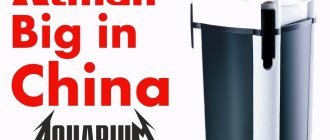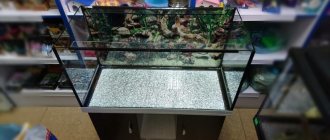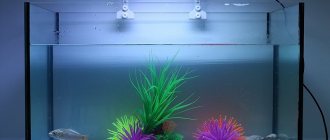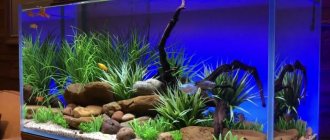09/23/201609/26/2016 master
Who among us doesn’t like bright aquariums with colorful inhabitants of different shapes and sizes? However, behind this beauty lies painstaking work, which involves constant monitoring of the water condition, ensuring gas exchange balance and sufficient illumination.
Often, aquarium lighting is needed not for fish, but for algae, which supply the water with additional oxygen and colonies of small invertebrates that are eaten by some types of fish. To create the right lighting for an aquarium with your own hands, you should know the characteristics of each species of flora and fauna living in it. The lack of illumination immediately affects the color of fish and plants; they intuitively adapt to the color of the bottom and general lighting. In the long term, lack of light can lead to the progression of diseases. But usually for most species, dim soft light generated by energy-saving lamps is comfortable. It is advisable to choose lamps that generate the most natural daylight. In this light, the tank itself will look better, and its inhabitants will be more comfortable. Harmful algae will not begin to grow, which means there will be no prerequisites for the development of atypical pathogenic flora and microorganisms. You can equip the aquarium lid, ends or bottom with lamps. The lighting should not be too intense so that the fish can hide from it at any time, observing the natural cycles of day and night. And there is no need for plants to bloom wildly all day long.
Which lamp is better to buy for an aquarium?
The following types of devices are used as a light source in indoor ponds:
Incandescent lamps (FL) are affordable and widely used in the past due to the lack of alternatives. Their glow has a good effect on vegetation, and the spectrum is similar to sunlight. However, they heat up the water greatly, consume a lot of electricity, are short-lived, and promote excessive algae growth.
Fluorescent (FL) lamps are the most widely used lamps and come in a huge variety of shapes and sizes. They are available with two types of bases (T8 and T5). T5 lamps are smaller in diameter and have rich directional light, but are much more expensive. Their disadvantage is that over time the glow spectrum shifts to the orange side and the growth of flora slows down.
Metal halide (MHL) - professional aquarists recommend this type of lamp for deep tanks with a height of more than 60 cm. They are durable, give a directed light flux - bright and penetrating to the depth. Their only drawback is the strong heating of the water. Such lighting should be installed at a height of 30 cm from the mirror and should not be immersed in water.
Light-emitting diode (LED) - regarding this illumination, aquarists have not yet come to a specific decision, since the practice of their use is not so wide. In addition, such lamps are very expensive.
Also, when choosing a backlight, you need to take into account its power. It is calculated per 1 liter of water and measured in watts:
- The best power to ensure bright color and lush growth of flora is 0.5-0.8 W/l.
- For “tropical” reservoirs it is below 0.3-0.5 W/l.
- For tanks with dense, tall vegetation – above 0.8 W/l.
For plant ponds, lighting is divided into groups according to power:
- 8-24W – for a shallow vessel with a length of up to 60 cm and a volume of up to 70 l;
- 25-38 W – for an oblong container up to 1 m in length and a volume of up to 370 l;
- 39-58 W is chosen for very large aquariums.
Light power is measured in lumens - it shows how much light a source produces. The higher this number, the deeper the light penetrates into the aquarium. A very important parameter for deep containers.
The spectral composition of light is important for aquarium flora. Light-loving plants need red and blue colors predominant in the spectrum for photosynthesis, while shade-loving plants need only blue.
Color temperature is another important parameter for choosing a lamp, as it determines the tone of the color:
- An indicator less than 5500 K favors the growth of algae;
- The emission spectrum of 5500-6500 K is good for shallow freshwater aquariums;
- 10,000 K and above will be required for deep seawater tanks.
Sunlight has the highest color rendering index (RA=100). Accordingly, the best lamps for an aquarium will be those with an RA value of 70 or more.
Recommendations: 10 Best Aquariums
12 Best Aquarium Plants
16 best aquarium fish
Important point
To ensure maximum safety for the inhabitants of the aquarium, be sure to choose special dust- and water-resistant lighting systems. The box of a suitable model must have a marking indicating the security index - IP. It characterizes the parameters of the product’s resistance to dust particles and splashes of water.
Protective properties
The first number indicates the level of protection against dust, the second – against moisture. Lamps with IP 55 are suitable for installation close to the water's edge, as they withstand the ingress of large dust particles, splashes and jets of water. Models with IP 56-58 can withstand full temporary immersion (even in salt water, which is aggressive for electronics). To install along the side of a water container, be sure to choose housekeepers or LED strips in a transparent silicone or matte acrylic “braid”. Such models have a high class of protection against water and dust, and can easily withstand direct contact with water, dust particles from dry food, etc. Please note that all additional elements of the circuit (power supply with controller, wiring, connecting terminals) must also be sealed so that splashes of water from splashing fish do not lead to a short circuit.
We hope that after reading this post, you will be inspired to create your own lighting in your home aquarium. Believe me, in any case, all the work and costs are worth it. Properly selected lighting transforms the appearance of any aquarium incredibly. And how effective and safe it will be depends on you.
Best Lamps for Saltwater Aquariums
Representatives of this category stand out for their power, allowing the light flux to pass to the very bottom without scattering. It is recommended to use them in deep, large containers. Sometimes these lamps have a function that imitates the light of the moon, which is important for the growth of coral reefs and the spawning of certain species of marine life.
JBL Solar Ultra Marine Day
4.9
★★★★★
editorial assessment
95%
buyers recommend this product
The white, coolish light of the lamp is ideal for a home pseudo-sea. This glow has a very beneficial effect on the growth of corals. The device has a high level of light output, so you don't have to worry about insufficient lighting at the bottom of the tank. The manufacturer guarantees 8000-10000 hours of uninterrupted operation of the lamp under favorable conditions.
Pros:
- Promotes the development of invertebrates;
- Easy to find on sale;
- Long service life;
- Low power consumption.
Minuses:
- Overpriced.
This lamp is ideal for a reef pond. To obtain excellent illumination and fluorescent results, it is recommended to combine it with Solar Ultra Marin Blue from the same manufacturer.
Hailea Extra Reef T5
4.8
★★★★★
editorial assessment
90%
buyers recommend this product
The model with a dominance of the blue-violet spectrum is suitable for the inhabitants of a marine aquarium, as it creates an imitation of the illumination of a coral reef at a depth of six meters. This light promotes the growth of unicellular organisms and corals.
Pros:
- Promotes coral growth;
- Excellent quality;
- Aesthetic appearance;
- Reasonable price.
Minuses:
- Rarely found in our stores.
Illumination with such a lamp will make your aquarium a copy of the seabed. Corals, sea fish and cichlids feel great in its light.
Hagen Marine Glo T8
4.6
★★★★★
editorial assessment
84%
buyers recommend this product
A fluorescent lamp from a Canadian manufacturer produces a limited-spectrum blue glow, ideal for saltwater aquariums. Such lighting will create the appearance of the seabed in the aquarium. In addition to its decoration function, the lamp has a beneficial effect on the growth of corals and invertebrates, and stimulates plant photosynthesis.
Pros:
- Does not increase water temperature;
- Many power options (from 15 to 40 W);
- Suitable for aquariums of different sizes (length 45-120 cm);
- Durable.
Minuses:
- Over time, it loses its “useful” properties.
Marine Glo is suitable for home ponds with reef-dwelling invertebrates. Its light has a good effect on their fluorescent pigments. It is recommended to combine it with Life-Glo or Power-Glo lamps.
READ ALSO
10 best terrariums
The best phytolamps for growing aquarium plants
Models from this category create the best conditions for photosynthesis and growth of aquarium plants. The lamps do not heat the water, do not burn the leaves and do not harm the fauna living nearby.
Dennerle Trocal Special Plant
5.0
★★★★★
editorial assessment
98%
buyers recommend this product
Dennerle lamps are manufactured using the new Longlife-Technik automated technology, which provides them with more than 10,000 hours of operation. The UV-stop coating film prevents the formation of algae directly on the lamp.
The spectrum gives a glow close to that of the sun and promotes rapid growth of plants (even very fastidious ones). High color rendering ensures that the fish are illuminated in the most advantageous shades.
Pros:
- Suitable for all aquarium lights;
- Very long working life;
- The UV-stop film also protects against flying fragments when dropped;
- Economical.
Minuses:
- Expensive.
To create a unique planted aquarium with proper vegetation, equip your pond with such a lamp. It will also help control algae growth.
Osram T8 Fluora
4.8
★★★★★
editorial assessment
89%
buyers recommend this product
The fluorescent model has proven itself well not only among aquarists, but also among those who like to grow indoor plants. Still, such a lamp is more appropriate for home ponds: its glow, with an emphasis on the red and blue spectral regions, activates the growth of flora and interestingly highlights aquatic inhabitants.
Pros:
- Does not heat water during operation;
- Many variations in power and size;
- Consumes energy economically;
- Affordable price.
Minuses:
- Over time, it loses its “special” properties.
If the plants in your herbalist have become dull and have stopped growing, pamper them with the glow of an Osram Fluora lamp - they will definitely thank you with lush growth.
Sylvania FHO T5 Aquastar
4.7
★★★★★
editorial assessment
85%
buyers recommend this product
The spectrum of a fluorescent lamp from a German brand with a high proportion of blue and red radiation is as close as possible to tropical sunlight. This model can be used for both freshwater and marine aquariums. It stimulates the lush growth of plants and corals, highlighting the natural color of fish.
Pros:
- Excellent light output;
- Provides excellent flora growth and protection from algae;
- Lots of power options.
Minuses:
- Light output decreases after 12 months of use due to natural aging.
With such lighting, a tropical aquarium will sparkle with new colors. And the glow of the lamp will not harm either flora or fauna.
READ ALSO
9 Best Aquarium Filters
How long should the lights be on?
Illumination of the aquarium is needed only during the daytime, since fish in natural conditions see both day and night. 24-hour illumination can cause algae to grow too quickly, which will certainly upset the balance of the ecosystem.
There are certain criteria that will help maintain optimal lighting for the aquarium:
- If the aquarium is located in a bright room located on the sunny side, then you need to turn on the light in it only a couple of hours after sunset, this will be quite enough to maintain ideal conditions.
- When the aquarium is on the non-sunny side, the light is turned on in the morning, and turned off at night or made as dim as possible.
- In order not to injure the fish, the lighting should be started gradually, the light in the room itself turns on immediately, and only later in the aquarium. If the backlight is equipped with a dimmer, it is programmed to gradually increase the intensity of the glow.
- The lights are also turned off gradually; the level of illumination in the lamps illuminating the aquarium is immediately gradually reduced, and after a few minutes the light in the room itself is extinguished.
Following these simple rules will help preserve the fish population in your “home sea.” Large representatives of the fauna react especially acutely to sudden changes in lighting.
Careless handling may cause them to hit the walls of the aquarium and decorative elements, causing injury to themselves. There were also cases when fish fell to the bottom and spent several days motionless, refusing food.
The Best Full Spectrum Lamps for an Aquarium
Representatives of this group emit natural white light, which is similar to natural daylight. Thanks to it, the aquarium plants receive the necessary conditions for development and growth, and the color of the fish becomes incredibly bright.
Sylvania Aqua-Classic T5
5.0
★★★★★
editorial assessment
97%
buyers recommend this product
The fluorescent lamp of the German brand Sylvania is manufactured according to new standards using tri-phosphor technology and combines two functions at once. The balanced ratio of blue-red radiation promotes photosynthesis, and at the same time favorably illuminates all inhabitants of flora and fauna. With such a lamp your aquarium will take on a fabulous look.
Pros:
- Suitable for aquariums of different types and shapes;
- The spectrum corresponds to natural sunlight;
- Perfectly illuminates both plants and fish;
- Excellent quality (made in Germany).
Minuses:
- High price.
The lamp is designed for beginner aquarists. Its radiation will ensure the proper development of plants and will perfectly highlight the natural color of the fish.
JBL Solar Ultra Natur LT T5
5.0
★★★★★
editorial assessment
96%
buyers recommend this product
The unusually bright lamp can be used in tropical tanks, both with sea and fresh water. Excellent color rendering will provide bright and at the same time natural shades of all the inhabitants of the aquarium. Some components of the spectrum do not decrease to “0” and form a flux of light from sky blue to ruby.
Pros:
- Very bright glow;
- Ideal for tropical flora and fauna;
- Easy to find on sale.
Minuses:
- Expensive.
This versatile and very powerful device is suitable for any indoor pond.










